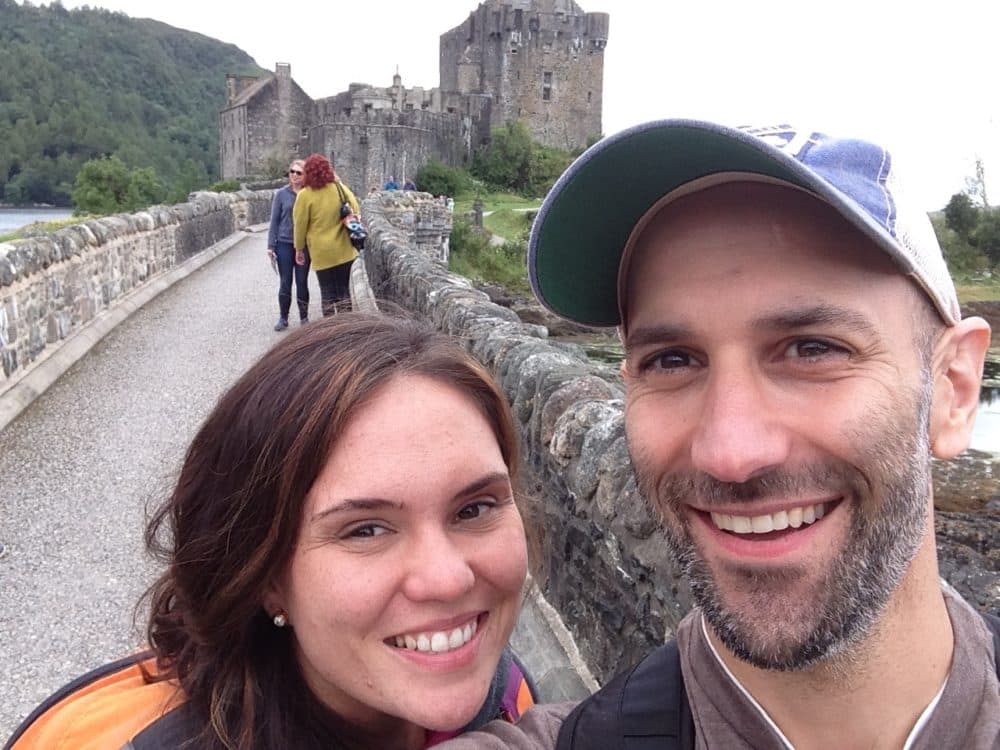Advertisement
Laura Levis' death outside ER has changed hospital signage, lighting in Mass.
Hospitals in Massachusetts will soon have to implement changes to make it easier for someone experiencing a medical crisis to find a hospital's emergency room and get help there.
The new regulations were announced Thursday at a State House press conference by Peter DeMarco, whose wife, Laura Levis, died from an asthma attack outside Somerville Hospital in September 2016. Levis couldn’t find her way to the emergency department and couldn’t find anyone to help her. She was 34.
Levis had walked to the hospital around 4 a.m., made her way up a hill to the emergency department and saw two doors. Neither was clearly marked. The one she walked to was locked. She called 911 and was transferred to multiple dispatchers. In a recording from one of those calls, she can be heard struggling to speak and breathe, saying she's having an asthma attack and is dying. Surveillance cameras captured the series of events.
"Her death should never have happened. It was the result of a complete breakdown in our emergency health care system and emergency 911 system," DeMarco said.
After Levis died, DeMarco turned from his career in journalism — he was a correspondent at The Boston Globe — to activism. For the past four years, he worked to get a new state law passed, which led to the regulations; he hopes they'll keep someone else from dying outside a hospital because they couldn't get help.
The requirements from the state Department of Public Health include signs, lights and directions from all access points, clearly directing people to emergency department entrances, along with video intercoms for people to call for help from outside an ER. They were finalized last June, but DPH just issued guidance to hospitals on the regulations this month.
Somerville Hospital, which is a part of Cambridge Health Alliance, issued a statement Thursday saying it took part in the working group and made recommendations to inform the new regulations. It said it's implemented changes consistent with the new regulations, including blue light emergency call stations, equipped with video, situated at parking garages and key entrances.
DeMarco spoke about the regulations with WBUR's All Things Considered host Lisa Mullins.
Interview Highlights
On the obstacles his wife faced as she sought help at Somerville Hospital during her medical emergency:
"The last sign she saw [for] the emergency department was on the street corner. So staring at the building, it wasn't clear where to go — left or right. The one on the right, the doorway, was was brightly [lit]. So she approached that doorway, and as she approached it, she could see through glass windows, but there was no one there.
"The door was locked. Actually, Laura also, I believe, figured out that while the door she was at was locked, the second door, which was dark, maybe that was a way to get in. And in reality, that was the official entrance to the emergency department, even though it had no sign above it. So she began walking [approximately 100 feet] toward that door and her attack overcame her, and she couldn't reach the door.
"She sat down on a bench. She called 911. She told the operator that she was having an asthma attack, that she was at the door of Somerville Hospital, that it was locked, and that she felt she was going to die."
On the high number of things that went wrong:
"There was no one at the security desk to watch the surveillance of her outside the hospital. Her 911 call went to a regional call center. It didn't go directly to the Somerville Police. The lights outside, where she had sat on the bench, were so almost nonexistent that when she collapsed. She was in near darkness, which is a reason why she wasn't seen [when a nurse came out to look for her].
"There was no lighted emergency sign [above] any door for her to have followed. So without that sign, she went to the wrong door, and that was locked. There was a complete breakdown of communication inside the emergency department, where even though two security guards were standing only feet away from the nurse who had received a call from the police department that someone was outside the hospital with an asthma attack and couldn't get in, that nurse never related that information to the security guards — the people whose job it is to patrol the hospital. The emergency responders who were called to the scene went to the wrong door, nowhere near where Laura was. Laura's cell phone didn't ping in the correct location. So emergency responders really didn't know exactly where she was. ... It was the perfect storm. Everything went wrong."
Advertisement

On how, in the midst of his grief, he pushed for new regulations:
"Well, by complete chance, I'm a journalist and I was able to write about Laura's story for The Boston Globe. ... And I wrote that story to make change. I wrote that story so people could learn from what happened to Laura — learn from the mistakes and never repeat them. After the story came out, it got a lot of publicity.
"A few weeks went by, though, and that publicity died away. And no one called me to say, 'I'm going to make changes. The state's going to do something. We're going to make these changes.' I didn't get that phone call.
"So after a few weeks, I realized that no matter how compelling a story you can write, it takes a person to make change, not just a story. So I decided to stop being a writer and to start being an advocate for change."
On the recommendations drawn up with the help of the working group he formed, which included architects, lighting experts, a wayfinding expert and people with disabilities:
"Every hospital in the state got a set of regulations [from] the Department of Public Health saying, here are the steps you need to take to make your emergency departments safer, to make them easy to find, to make them easy to get inside, and to eliminate as much confusion as possible for patients.
You're going to start to see new signs go up. You're going to start to see video/audio intercoms at doors. You're going to start to see better lighting. Hospitals now have until Jan. 1 to comply with more than a dozen new regulations from Laura's Law that I think are going to make an incredible difference."
On what people can do if they see a hospital that has not complied with the regulations come Jan. 1:
"After January, if you have trouble getting to an emergency department for any reason, number one, you could call the hospital and tell them. I think they'll be a lot more responsive. And you'll be able to call Department Public Health and say, 'I don't believe that laws [or] regulations are being followed at the hospital.'
"But I think hospitals [have gotten] the message. I think they want to make it better for their patients. They want to make it safer. They don't want anyone to die like Laura."

